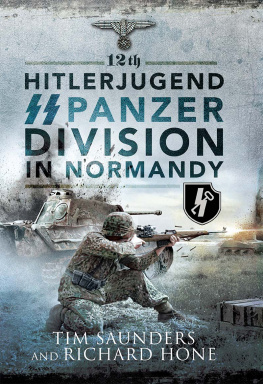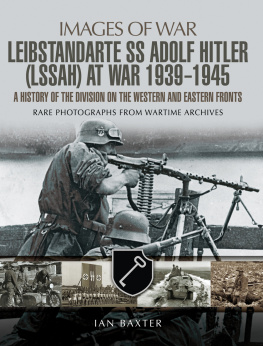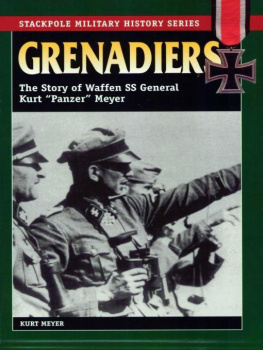F or my brother,
Lyle English,
and our cousin,
Superintendent Cecil Weigum,
Royal Canadian Mounted Police
Who Were the Waffen SS?
T
he fighting formations of the SS ( Sch u tzstaffel or protection squad) encountered by Allied forces during the Normandy campaign belonged to the Waffen (armed military) branch of Reichsfhrer-SS Heinrich Himmler's greater SS empire. Himmler's far-reaching SS bureaucracy and security service controlled all police forces within Germany and occupied areas, oversaw the concentration camp and forced-labor system, and set in train racial indoctrination, resettlement, and extermination programs. The growth of the Waffen SS followed the expansion of the Allgemeine (general) SS, originally an adjunct of the Sturmabteilung (SA) brown shirts of the National Socialist party army formed in 1921. The SA itself sprang from volunteer paramilitary Freikorps of disenchanted anticommunist veterans of World War I who attributed German defeat to a stab in the back. The German Army, restricted to 100,000 troops by the terms of the Versailles Treaty, initially viewed the swaggering SA as a complementary means of buttressing German military strength. The SA was temporarily outlawed, however, after the abortive Munich putsch of November 1923 in which Adolf Hitler and his SA stormtroopers attempted to establish a National Socialist government by coup.
From this experience, Hitler decided to gain power through more democratic methods, but not so the SA under his lieutenant, Ernst Rhm, who continued to advocate the violent overthrow of the republic and the replacement of the army with a people's revolutionary militia. Hitler, on the other hand, saw that mindless bully tactics by the SA could well jeopardize the growing probability of National Socialist victory at the polls. He further feared that the army, recognized as the legitimate bearer of arms for the German state, might begin to look upon the nearly three-million-strong SA as a competitor rather than an avenue for desired army expansion and therefore act against it. Thus, while striving not to alienate his storm-troop supporters, Hitler came to view the SA as a liability and Rhm as a potential challenger.
What Hitler needed was a counterforce, an internal party agency that owed complete allegiance not to some violent revolutionary creed, but to him and him alone. As a first step, Hitler reformed his armed personal bodyguard by establishing several Stosstrupp squads in cities he intended to visit. In January 1929, he also appointed his Ignatius Loyola, as he called Himmler, to take command of this new organization of some 280 men. The ambitious Himmler in turn established the SS Security Service, the SD ( Sicherheitsdienst ), in 1931 and recruited Reinhard Heydrich in 1934 to head the branch. Under Himmler, the SS grew to 400 by January 1931 and to 52,000 by January 1933. Through intimidation and other maneuvers, Himmler and Heydrich asserted SS police control throughout Germany. In late 1933, Himmler also set up his own concentration camp at Dachau staffed by Toten kopfver bnde (death's head groups) guards commanded by Standartenfhrer Theodor Eicke, who would later, as Gruppenfhrer prison camp czar, extend the Dachau model to all of Germany. Eventually, the importance and membership of the fountainhead Allgemeine SS eroded as the SD, police, and Waffen SS grew in size and significance to become the three pillars of Himmler's empire.
Himmler further established the black-uniformed Stabwache (staff guard) headed by Sepp Dietrich, one of Hitler's original henchmen,
and officered by Wilhelm Mohnke, Theodor Wisch, and Fritz Witt among others. In March 1933, Hitler ordered the Stabwache to assume the duty of guarding the Reich Chancellery in Berlin as SS Sonderkommando Berlin . In June 1933, two more Sonderkommandos were organized and trained at Jterbog and Zossen army camps. In September, all three paraded together as a regiment under the new title Adolf Hitler Standarte . On 9 November 1933, on the tenth anniversary of the Munich putsch , the regiment, now renamed Leibstandarte Adolf Hitler , collectively took the oath, I swear to you, Adolf Hitler, as Fhrer and Chancellor of the German Reich, loyalty and bravery. I pledge to you, and superiors appointed by you, obedience unto death, so help me God. Engraved upon their belt buckles were the words, Meine Ehre heisstTreue (My honor is loyalty). On their headdress, the men of the Leibstandarte wore the death's head badge traditionally common to many armies, but on their collars, they sported silvered Nordic lightning Siegrunen signifying victory.
In February 1934, Hitler decreed that the armed SS, to be known as the Verfgungstruppe (disposal force), was to be organized and equipped in accordance with scales established by the army command. With the connivance of the army, he also settled his SA problem by liquidating Rhm and the top SA leadership during the Night of the Long Knives at Bad Wiessee on 30 June 1934. For the leading parts played by Himmler, Dietrich, and Eicke, who personally killed Rhm on Hitler's order, Hitler elevated the SS to the status of an independent organization within the National Socialist Worker's Party.
Buoyed by Hitler's confidence in the SS as a trustworthy force, Himmler now requested an increase in armed SS strength as the Leibstandarte Adolf Hitler remained only of regiment size at the end of the year. While Hitler looked upon this request favorably, especially since he harbored reservations about the loyalty of his conservative army generals, he was also aware that the surest way to erode that loyalty was to raise the specter of a another party army threatening to replace the traditional force and legitimate bearer of arms for the German state. In his announcement of conscription on 16 March 1935, Hitler compromised, stating his intention to increase the Verf- gungstruppe to division size, but stipulating that it was to be incorporated into the army and subject to military law in wartime. Though funded from the Reich police budget, the Verfgungstruppe did not initially draw recruits from the Totenkopfverbnde . Two of its regiments, the Deutschland and Germania , were raised instead from isolated SS units set up in major German cities during 1933, while the third regiment, Leibstandarte Adolf Hitler , retained a measure of autonomy owing to Dietrich's close friendship with Hitler.
Himmler, who now privately inclined to Rhm's idea of replacing the traditional army with a more politically committed force, appointed Brigadefhrer Paul Hausser in 1936 to head the Verfgung - struppe . Hausser had retired from the army in 1932 as a lieutenant general and, from 1935, set up SS cadet training centers at Bad Tlz and Brunswick to produce the future officers of the SS. Himmler envisioned turning the political soldiery of the SS into a modern version of medieval crusading orders and Jesuits of the Counter-Reformation. Ideological indoctrination accordingly figured prominently in the training system, which downplayed drill, except in the case of the Leibstandarte , and emphasized fighting skills, physical fitness, and live-fire exercises. The armed SS retained the SA rank structure and differed from the army in encouraging an egalitarianism among ranks. All ranks addressed each other as kamerade , and all officers had to serve first in the ranks. Educational requirements to join the armed SS were, however, lower than those of the army. Many men refused by the army thus joined the armed SS, which consisted largely of lower-middle-class or working-class German citizens. Not all who entered the ranks of the armed SS did so for ideological reasons. Some joined for more rapid advancement, others out of a desire for social prestige or belonging to an exclusive organization, and many for the glamour of wearing a smart black uniform. Once in, they also became members of a tight-knit brotherhood of arms.
Next page





